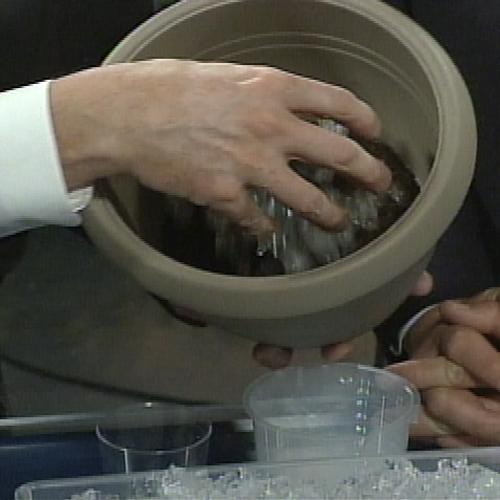Water Jelly Crystals are an example of a water-absorbing polymer called a hydrogel. Think of these hydrogels as long chains of molecules (called polymers) that absorb incredible amounts of water, only to release the water to plant roots at a later time. Hydrogels are rapidly becoming one of the most exciting environmental education topics in classrooms worldwide. Today, superabsorbent polymers are widely used in such applications as forestry, gardening, and landscaping as a means of conserving water. Imagine using a substance that could store water in the soil and then release it as the plant’s roots need it. While we may consider water-absorbing polymers to be a modern convenience, imagine the impact that such technology is having on parts of the world that are plagued by drought.
Gardening with Hydrogel Crystals
Using Water Jelly Crystals to help conserve water in the garden.

Experiment
Here are some of our favorite tips for using Water Jelly Crystals in your garden and for all your landscaping needs:
Background
HydroSource (cross-linked polyacrylamide) is a long lasting, easy to use, water absorbing soil additive. In gardens, house plants, and landscaping it increases the soil’s water holding capacity. You can either improve the growth of the plant or decrease the watering frequency. It usually lasts 4-5 years in the soil.
General Performance
One pound of HydroSource will absorb up to 35 gallons of rainwater or snowmelt and 20-25 gallons of tap water, depending on the salt content of the water. HydroSource can be applied wet or dry. Dry granules are usually easier to use, but soak them thoroughly to fully fill them with water. When hydrated, the granules look like chunks of clear gelatin about 1/2 inch in diameter.
Dry Application
For large quantities of potting soil or backfill around trees and shrubs use 1.5-2 pounds/ cubic yard of potting soil or backfill or 1 ounce/ cubic foot of soil. For small quantities of potting soil use 1/2 tsp per quart of soil. Note: Since dry granules swell to many times their original size when water is added, 15-20% swelling room must be left in each planting hole or flower pot to compensate.
Wet Application
Best for small applications such as repotting house plants and planting shrubs, small trees, and bedding plants. 1/2 tsp of dry granules absorbs approximately 1 cup of water. 1 ounce of dry granules absorbs approximately 1 1/2 cups of water. 1 pound of dry granules absorbs approximately 30 gallons of water. Mix the granules in water and allow them to stand for 60-90 minutes (hot water works faster). Once you have the polymer all soaked up, the application rate is roughly one part hydrated polymer to four parts soil.
House/Office Plants
- 6″ pot (2/3 gal) – use 1 tsp dry or 2 cups hydrated
- 8″ pot (1 1/2 gal) – use 2 Tbsp dry or 6 cups hydrated
- 5 gallon pot – use 7 tsp dry or 1 gallon hydrated
Note: Mix HydroSource® in lower half of the pot because the water tends to flow quickly through porous potting soil before the granules near the top have time to re-hydrate fully.
Repotting
Using the above rates, mix granules or hydrated gel thoroughly in the lower half of the pot. If using dry granules, fill the soil only to within 1 inch of the pot rim to prevent swelling out of the pot.
Existing Plants
Depending on container size, use a pencil or wooden spoon handle to poke 4-6 holes around the plant, going to the bottom. Divide the correct amount of dry granules evenly among the holes, pushing them to the bottom. Water slowly to hydrate the granules. Wait at least 2-3 weeks before changing watering intervals to give feeder roots a chance to grow into the granules.
Vegetable and Flower Gardens
Use 4-5 pounds/ 100 sq feet for low-water adapted flowers and up to 10 pounds/100 sq feet for water loving vegetable and flowers. Hint: The addition of weed-barrier fabric will further reduce the need for water or weeding. By hand, or using a spreader, distribute the granules evenly over the leveled bed and then turn under. Bedding plants may be given a quick start by mixing a handful of hydrated gel in the back fill of each plant, taking care not to leave clumps of gel. Water the bed thoroughly after planting.
Trees and Shrubs
Dig a hole 5 times the diameter, but no deeper than, the root ball or container. To figure out the amount of dry granules needed to mix in the backfill, just calculate the amount of backfill and figure one ounce of granules per cubic foot. The bigger the hole the more polymers you can use and the morewater storage you’ll gain.
New or Seeded Turf
Watering intervals can be extended approximately one day for each 7 1/2 pounds of HydroSource® per 1000 sq feet given evaporation rates of .25″ per day. For example, 15 lbs of granules normally stores 1/2″ of extra water (two additional days between waterings) and 30 pounds stores 1″ of water (four additional days between watering). Warning: To avoid making a soft lawn, never use more than 5 pounds of HydroSource® per tilled inch per 1000 square feet. Thus, 20 pounds must be tilled in 4 inches; 30 pounds 6 inches. Increase application rate roughly 10% over sloped areas. Save one pound to spread over the top of each 1000 sq ft. before laying sod (but not if you are seeding, as it just breaks down in the wet phase if not covered by soil.) Water thoroughly and slowly. By hand, or using a spreader, distribute the granules evenly before rototilling to appropriate depth.
Additional Info
For more information on the science behind Water Jelly Crystals visit our Water Jelly Crystal experiment and our Water Absorbing Crystals experiment.
Look for Steve Spangler using superabsorbent “Hydrogel” polymers as the 2008 National 4-H Youth Science Day Spokesperson.
